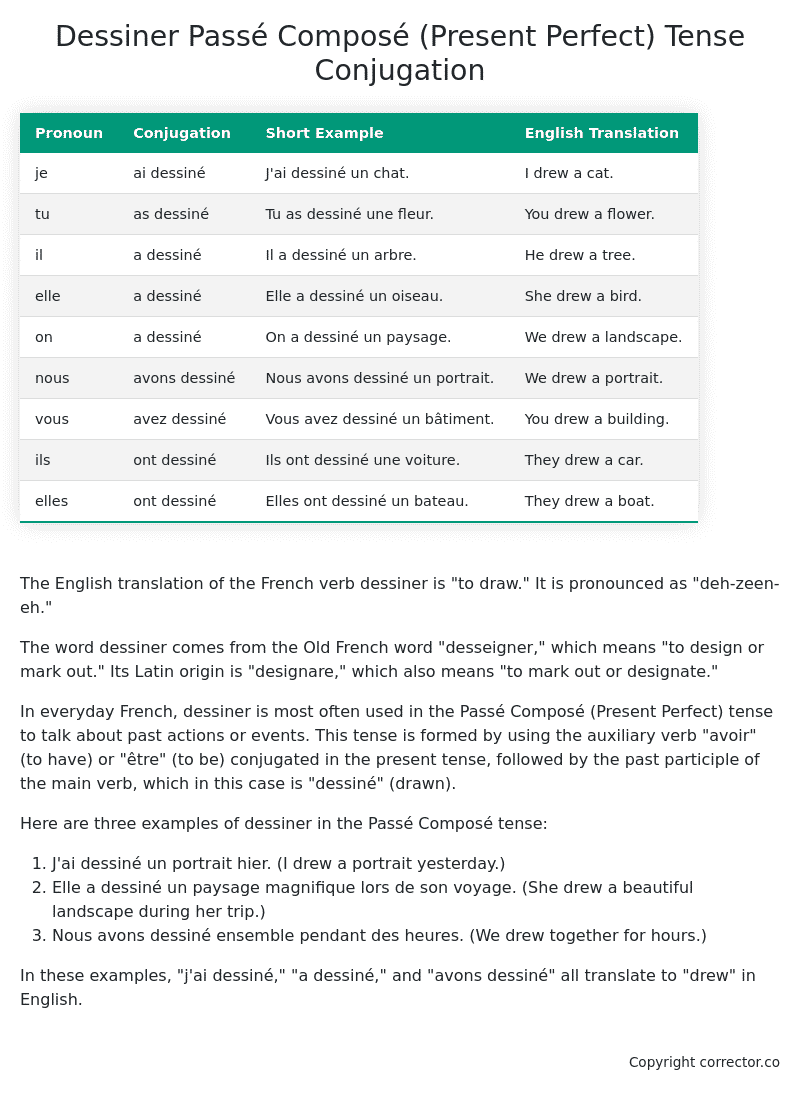Passé Composé (Present Perfect) Tense Conjugation of the French Verb dessiner
Introduction to the verb dessiner
The English translation of the French verb dessiner is “to draw.” It is pronounced as “deh-zeen-eh.”
The word dessiner comes from the Old French word “desseigner,” which means “to design or mark out.” Its Latin origin is “designare,” which also means “to mark out or designate.”
In everyday French, dessiner is most often used in the Passé Composé (Present Perfect) tense to talk about past actions or events. This tense is formed by using the auxiliary verb “avoir” (to have) or “être” (to be) conjugated in the present tense, followed by the past participle of the main verb, which in this case is “dessiné” (drawn).
Here are three examples of dessiner in the Passé Composé tense:
- J’ai dessiné un portrait hier. (I drew a portrait yesterday.)
- Elle a dessiné un paysage magnifique lors de son voyage. (She drew a beautiful landscape during her trip.)
- Nous avons dessiné ensemble pendant des heures. (We drew together for hours.)
In these examples, “j’ai dessiné,” “a dessiné,” and “avons dessiné” all translate to “drew” in English.
Table of the Passé Composé (Present Perfect) Tense Conjugation of dessiner
| Pronoun | Conjugation | Short Example | English Translation |
|---|---|---|---|
| je | ai dessiné | J’ai dessiné un chat. | I drew a cat. |
| tu | as dessiné | Tu as dessiné une fleur. | You drew a flower. |
| il | a dessiné | Il a dessiné un arbre. | He drew a tree. |
| elle | a dessiné | Elle a dessiné un oiseau. | She drew a bird. |
| on | a dessiné | On a dessiné un paysage. | We drew a landscape. |
| nous | avons dessiné | Nous avons dessiné un portrait. | We drew a portrait. |
| vous | avez dessiné | Vous avez dessiné un bâtiment. | You drew a building. |
| ils | ont dessiné | Ils ont dessiné une voiture. | They drew a car. |
| elles | ont dessiné | Elles ont dessiné un bateau. | They drew a boat. |
Other Conjugations for Dessiner.
Le Present (Present Tense) Conjugation of the French Verb dessiner
Imparfait (Imperfect) Tense Conjugation of the French Verb dessiner
Passé Simple (Simple Past) Tense Conjugation of the French Verb dessiner
Passé Composé (Present Perfect) Tense Conjugation of the French Verb dessiner (this article)
Futur Simple (Simple Future) Tense Conjugation of the French Verb dessiner
Futur Proche (Near Future) Tense Conjugation of the French Verb dessiner
Plus-que-parfait (Pluperfect) Tense Conjugation of the French Verb dessiner
Passé Antérieur (Past Anterior) Tense Conjugation of the French Verb dessiner
Futur Antérieur (Future Anterior) Tense Conjugation of the French Verb dessiner
Subjonctif Présent (Subjunctive Present) Tense Conjugation of the French Verb dessiner
Subjonctif Passé (Subjunctive Past) Tense Conjugation of the French Verb dessiner
Subjonctif Imparfait (Subjunctive Imperfect) Tense Conjugation of the French Verb dessiner
Subjonctif Plus-que-parfait (Subjunctive Pluperfect) Tense Conjugation of the French Verb dessiner
Conditionnel Présent (Conditional Present) Tense Conjugation of the French Verb dessiner
Conditionnel Passé (Conditional Past) Tense Conjugation of the French Verb dessiner
L’impératif Présent (Imperative Present) Tense Conjugation of the French Verb dessiner
L’infinitif Présent (Infinitive Present) Tense Conjugation of the French Verb dessiner
Struggling with French verbs or the language in general? Why not use our free French Grammar Checker – no registration required!
Get a FREE Download Study Sheet of this Conjugation 🔥
Simply right click the image below, click “save image” and get your free reference for the dessiner present perfect tense conjugation!

Dessiner – About the French Passé Composé (Present Perfect) Tense
Formation of the Passé Composé
Set the auxiliary verb with either
Conjugate the auxiliary verb
Add the past participle
Common everyday usage patterns
Narrating Past Events
Sequential Actions
Describing Completed Actions
Interactions with other tenses
Imperfect Tense
Conditional and Future Tenses
Summary
I hope you enjoyed this article on the verb dessiner. Still in a learning mood? Check out another TOTALLY random French verb conjugation!


